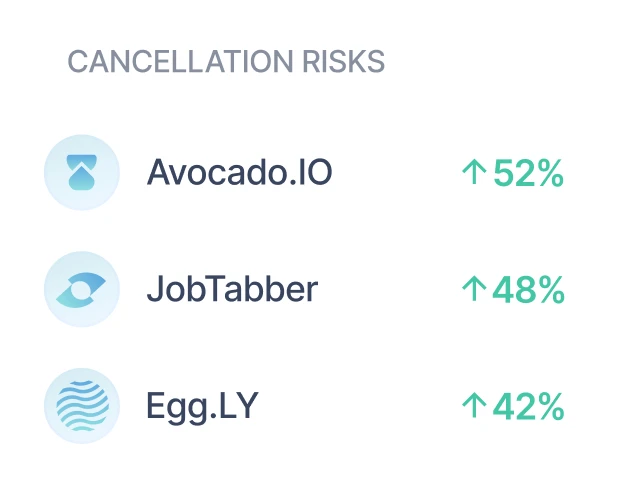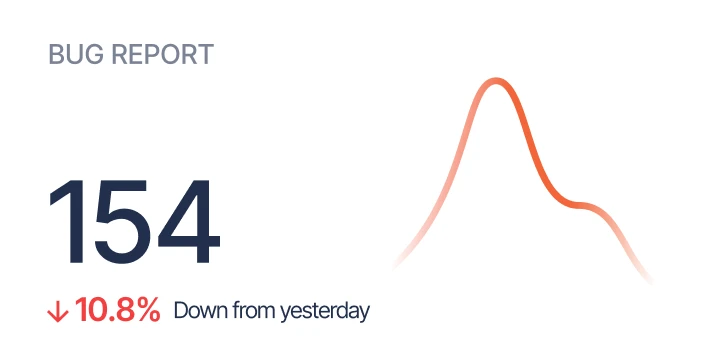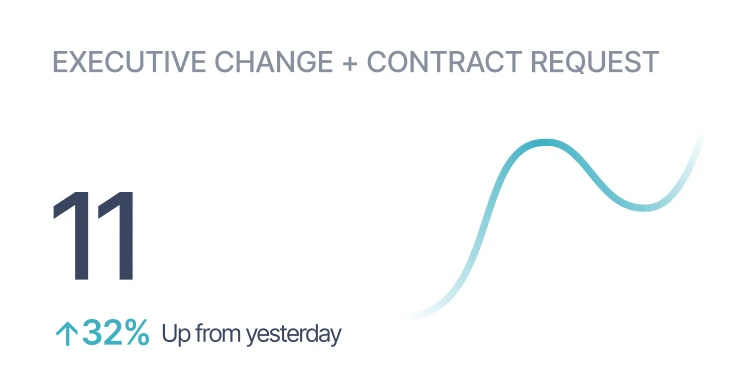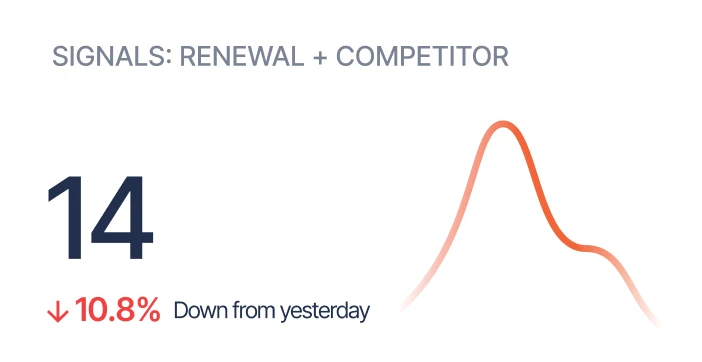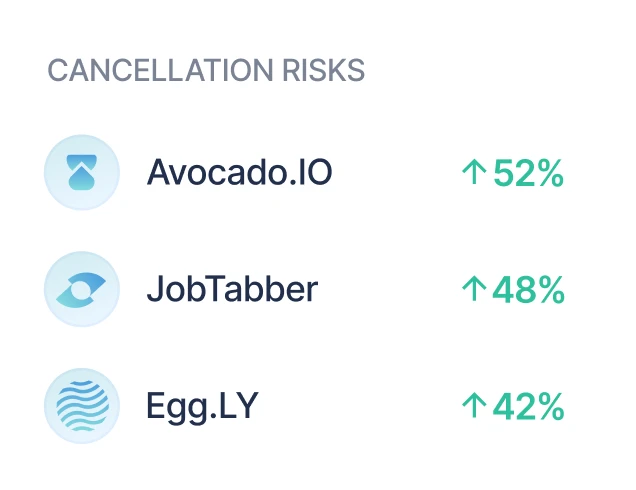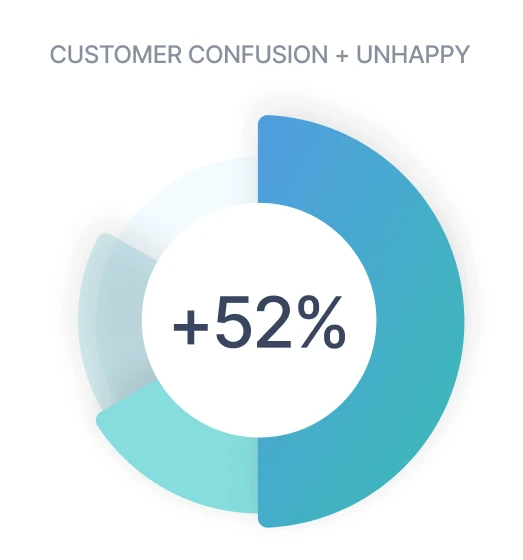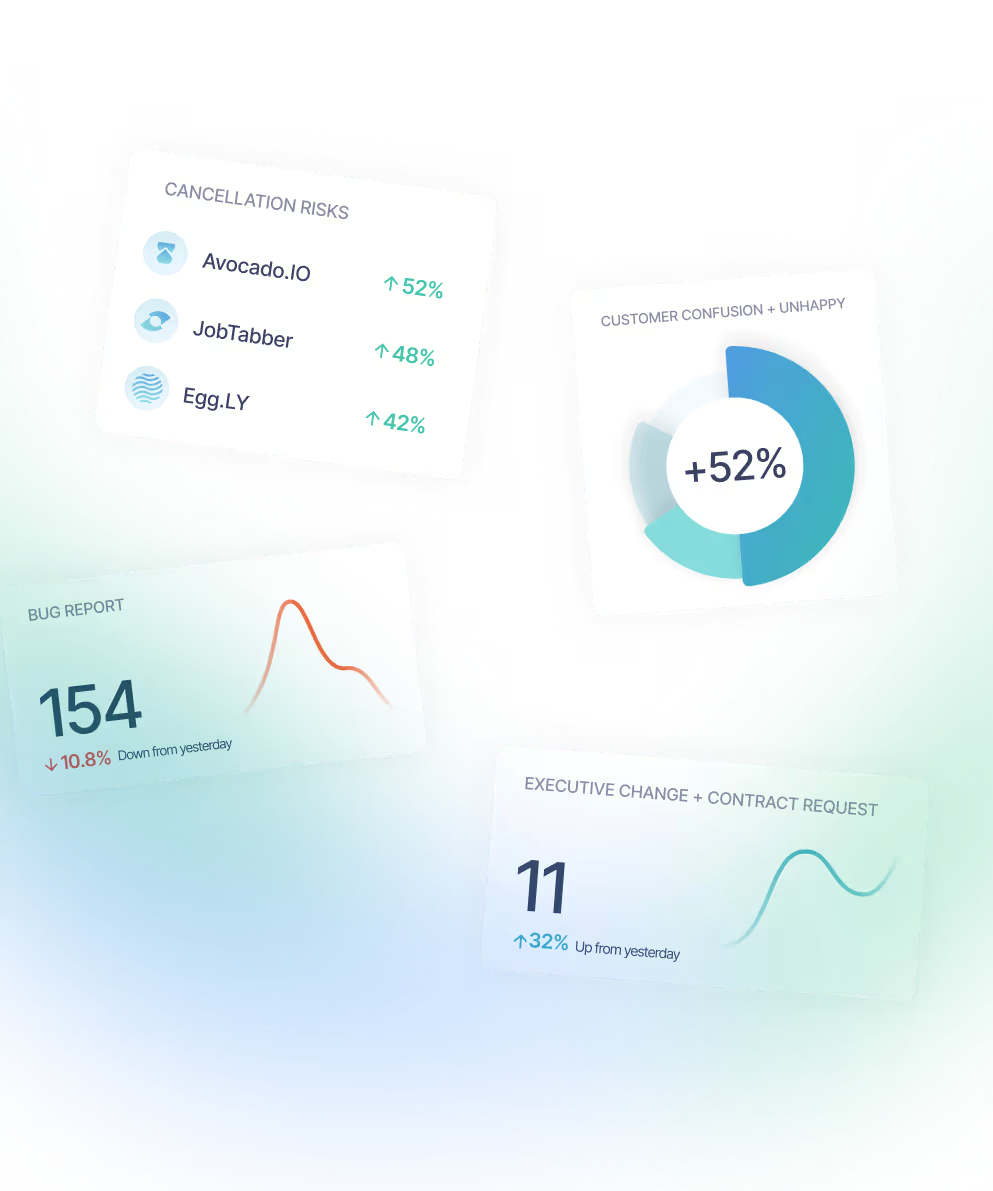our insight
AI tips & trends
Join CX, product, ops, and engineering leaders worldwide that receive The Signal - Sturdy's Blog Newsletter.

STURDY.AI ANNOUNCES $6M SEED ROUND
Sturdy's Customer Intelligence Platform performs real-time revenue threat root cause analysis, and delivers cross-functional insights to the teams and systems to mitigate churn.
Portland, OR — April 1, 2025 — Sturdy.ai, a pioneer in AI-powered customer intelligence, today announced it has raised $6M in Series Seed funding. Voyager Capital led this round, with participation from Fortson VC as well as existing investor, Grotech Ventures. The funds will be used to deepen Sturdy’s AI capabilities, expand integrations with customer data silos, and grow its go-to-market and engineering teams.
Modern Teams Need Actionable Intelligence to Protect and Grow Revenue
With customer expectations higher than ever and retention under pressure, the need for proactive, AI-driven revenue insights has never been more urgent. According to industry data, reducing churn by just 5% can increase profits by up to 95%. Enterprises have spent millions on building silos of applications to get closer to their customers and create active communication channels in the hope of mitigating churn risk early. Yet, this has failed to provide the proactive warning signals required. Sturdy closes the gap by seeing across these silos for a unified view of customer communication.
“We’re creating an AI-first intelligent interface for all things customer. This allows Sturdy to provide an almost magical understanding of every customer interaction across every data silo,” said Steve Hazelton, CEO and co-founder of Sturdy.ai. “This funding enables us to move faster to empower teams to stay ahead of risk and unlock new revenue opportunities.”
Investors Bet Big on AI-Powered Revenue Threat Detection
The funding round attracted a strong syndicate of investors aligned on Sturdy’s vision for a more innovative, AI-native approach to revenue intelligence. Voyager Capital, known for backing category-defining SaaS platforms, led the round, with General Partner Diane Fraiman joining Sturdy's board.
“Sturdy is tackling one of the most urgent and overlooked problems in enterprise software—how to extract proactive insights from the flood of daily customer interactions,” said Diane Fraiman, Managing Director of Voyager Capital. “Retention has become a critical topic in boardrooms. We believe that every business will have a system of intelligence in the next 3 years. Sturdy’s platform is positioned to become essential infrastructure for any company serious about protecting and growing revenues while truly putting their customers first.”
“Sturdy is one of the most powerful and immediate applications of AI and natural language processing we’ve seen,” said Thomas O’Keefe, CEO of Solo LLC. “At both Solo and previously at Syntrio, it has delivered instant value—surfacing proactive, actionable customer insights and driving measurable improvements in retention.”
About Voyager
Voyager Capital is a leading West Coast early-stage venture firm, providing entrepreneurs with the resources, experience, and connections to build successful companies for today’s modern economy. Voyager invests primarily in B2B technology companies, including AI-driven business solutions, software-driven hardware, sustainable agriculture, and supply chain. The firm's domain expertise, go-to-market, and team-building resources are proven to help build market leaders. Voyager Capital has over $550 million under management with offices and resources in Seattle, Portland, Vancouver, and Calgary.
About Fortson VC
Fortson VC is a seed-stage venture firm based in the Pacific Northwest, built for exceptionally rare founders who are pushing the boundaries of what’s possible. Led by Cole Younger, Fortson brings over two decades of early-stage investing experience and a disciplined approach grounded in authenticity, grit, and courage. While driven by curiosity, our primary focus is B2B software and the technological frontier around it—the infrastructure, intelligence, and automation shaping the future of how businesses create value.
About Grotech Ventures
Founded in 1984, Grotech Ventures is a leading early investor in high-potential technology companies. Grotech seeks innovative, early-stage investments across the technology landscape and continues to invest and add value throughout the life cycle of each portfolio company. The firm has a strong combination of financial backing, industry relationships, and deep domain and operational expertise to accelerate growth. With more than $1.0 billion in committed capital, Grotech supports early-stage companies through investments starting as small as $500,000. For more information, visit http://www.grotech.com.
About Sturdy
Founded in 2020, Sturdy is an AI-forward autonomous Customer Intelligence platform that proactively identifies churn risks across all customer-facing silos. Sturdy analyzes unstructured customer interactions—emails, calls, support tickets, chats, and more—discovering revenue threats, pinpointing root causes, and delivering cross-functional insights in real time. Sturdy has analyzed billions of customer interactions, giving it one of the largest proprietary datasets in the category and enabling its models to surface insights faster and more accurately than competitors. At a time when customer retention is a top priority for every business, Sturdy turns the noise of customer conversations into a strategic advantage.
For more information, visit www.sturdy.ai or reach out to Joel Passen at joel@sturdy.ai
Sturdy's Customer Intelligence Platform performs real-time revenue threat root cause analysis, and delivers cross-functional insights to the teams and systems to mitigate churn.
Portland, OR — April 1, 2025 — Sturdy.ai, a pioneer in AI-powered customer intelligence, today announced it has raised $6M in Series Seed funding. Voyager Capital led this round, with participation from Fortson VC as well as existing investor, Grotech Ventures. The funds will be used to deepen Sturdy’s AI capabilities, expand integrations with customer data silos, and grow its go-to-market and engineering teams.
Modern Teams Need Actionable Intelligence to Protect and Grow Revenue
With customer expectations higher than ever and retention under pressure, the need for proactive, AI-driven revenue insights has never been more urgent. According to industry data, reducing churn by just 5% can increase profits by up to 95%. Enterprises have spent millions on building silos of applications to get closer to their customers and create active communication channels in the hope of mitigating churn risk early. Yet, this has failed to provide the proactive warning signals required. Sturdy closes the gap by seeing across these silos for a unified view of customer communication.
“We’re creating an AI-first intelligent interface for all things customer. This allows Sturdy to provide an almost magical understanding of every customer interaction across every data silo,” said Steve Hazelton, CEO and co-founder of Sturdy.ai. “This funding enables us to move faster to empower teams to stay ahead of risk and unlock new revenue opportunities.”
Investors Bet Big on AI-Powered Revenue Threat Detection
The funding round attracted a strong syndicate of investors aligned on Sturdy’s vision for a more innovative, AI-native approach to revenue intelligence. Voyager Capital, known for backing category-defining SaaS platforms, led the round, with General Partner Diane Fraiman joining Sturdy's board.
“Sturdy is tackling one of the most urgent and overlooked problems in enterprise software—how to extract proactive insights from the flood of daily customer interactions,” said Diane Fraiman, Managing Director of Voyager Capital. “Retention has become a critical topic in boardrooms. We believe that every business will have a system of intelligence in the next 3 years. Sturdy’s platform is positioned to become essential infrastructure for any company serious about protecting and growing revenues while truly putting their customers first.”
“Sturdy is one of the most powerful and immediate applications of AI and natural language processing we’ve seen,” said Thomas O’Keefe, CEO of Solo LLC. “At both Solo and previously at Syntrio, it has delivered instant value—surfacing proactive, actionable customer insights and driving measurable improvements in retention.”
About Voyager
Voyager Capital is a leading West Coast early-stage venture firm, providing entrepreneurs with the resources, experience, and connections to build successful companies for today’s modern economy. Voyager invests primarily in B2B technology companies, including AI-driven business solutions, software-driven hardware, sustainable agriculture, and supply chain. The firm's domain expertise, go-to-market, and team-building resources are proven to help build market leaders. Voyager Capital has over $550 million under management with offices and resources in Seattle, Portland, Vancouver, and Calgary.
About Fortson VC
Fortson VC is a seed-stage venture firm based in the Pacific Northwest, built for exceptionally rare founders who are pushing the boundaries of what’s possible. Led by Cole Younger, Fortson brings over two decades of early-stage investing experience and a disciplined approach grounded in authenticity, grit, and courage. While driven by curiosity, our primary focus is B2B software and the technological frontier around it—the infrastructure, intelligence, and automation shaping the future of how businesses create value.
About Grotech Ventures
Founded in 1984, Grotech Ventures is a leading early investor in high-potential technology companies. Grotech seeks innovative, early-stage investments across the technology landscape and continues to invest and add value throughout the life cycle of each portfolio company. The firm has a strong combination of financial backing, industry relationships, and deep domain and operational expertise to accelerate growth. With more than $1.0 billion in committed capital, Grotech supports early-stage companies through investments starting as small as $500,000. For more information, visit http://www.grotech.com.
About Sturdy
Founded in 2020, Sturdy is an AI-forward autonomous Customer Intelligence platform that proactively identifies churn risks across all customer-facing silos. Sturdy analyzes unstructured customer interactions—emails, calls, support tickets, chats, and more—discovering revenue threats, pinpointing root causes, and delivering cross-functional insights in real time. Sturdy has analyzed billions of customer interactions, giving it one of the largest proprietary datasets in the category and enabling its models to surface insights faster and more accurately than competitors. At a time when customer retention is a top priority for every business, Sturdy turns the noise of customer conversations into a strategic advantage.
For more information, visit www.sturdy.ai or reach out to Joel Passen at joel@sturdy.ai
Our articles
.png)
Have you heard this from your CEO?
"How are we using AI internally?"
The drumbeat is real. Boards are leaning in. Investors are leaning in. Yet, too many leaders hardly use it. Most CS teams? Still making excuses.
🤦🏼 "We’re not ready."Translation: We don't know where to start, so I'm waiting to run into someone who has done something with it.
🤦🏼 "We need cleaner data."Translation: We’re still hoping bad inputs from fractured processes will magically produce good outputs. Everyone's data is a sh*tshow. Trust me. 🤹🏼♂️ "We're playing with it."Translation: We have that one person messing with ChatGPT - experimenting.
😕 "Just don't have the resources right now."Translation: We're too overwhelmed manually building reports, wrangling renewals, and answering tickets forwarded by the support teams.
🫃🏼 "We've got too many tools."Translation: We’re overwhelmed by the tools we bought that created a bunch of silos and forced us into constant app-switching.
🤓 "Our IT team won't let us use AI."Translation: We’ve outsourced innovation to a risk-averse inbox.
It's time to put some cowboy under that hat 🤠 . No one’s asking you to rebuild the data warehouse or perform some sacred data ritual. You don’t need a PhD in AI.
You can start small.
Nearly every AI vendor has a way for you to try their wares without hiring a team of talking heads to perform unworldly 🧙🏼 acts of digital transformation.
Where to start.
✔️ Pick a use case that will give you a revenue boost or reveal something you didn't know about your customers.
✔️ Choose something that directs valuable work to the valuable people you've hired.
✔️ Pick something with outcomes that other teams can use.
Pro Tip: Your CEO doesn't care about chatbots, knowledgebase articles, or things that write emails to customers.
What do you have to lose? More customers? Your seat at the table?
.png)
Talent gets you started. Infrastructure gets you scale.
We obsess over hiring A-players. But even the best GTM talent will flounder if the foundation isn’t there.
I’ve seen companies overpay for “rockstars” who quit in 6 months—not because they weren’t capable, but because they were dropped into chaos. No ICP. Bad data. No process. No enablement. No system to measure or coach.
Great GTM teams aren’t built on purple squirrels. They’re built on a strong foundation.
That foundation looks like this:
✅ A crisp, written ICP and buyer persona (not just tribal knowledge)
✅ Accurate prospect data to target the right ICP
✅ A playbook that outlines how you win—and how you lose
✅ A clear point-of-view that your team can rally around in every email, call, and deck
✅ Defined stages, handoffs, and accountability across marketing, sales, CS
✅ A baseline reporting system to see what’s working—and what’s not
When this exists, you can onboard faster, coach better, and scale smarter. It's not easy, and it’s not sexy, but it works.
Want to cut CAC and increase ramp speed? Start with your infrastructure. Hire into a structure.
.png)
The Three Biggest Problems Facing B2B SaaS in 2025
Most B2B SaaS companies still operate like it's 2020. Everything changed: customer expectations, growth efficiency, and competitive dynamics have flipped.
Here’s what’s changed:
Net-New Growth is Slowing: Recent benchmarks show it’s not just a feeling—it's a trend. The 2024 SaaS Capital Performance Metrics Benchmark report notes a pivot from "growth at any cost" to "lower growth at reduced efficiency," with CAC Ratios, Payback Periods, and Net Revenue Retention all trending in the wrong direction. The biggest slowdowns? Private SaaS companies in the $10-$20M ARR range, where growth rates dropped sharply from 2022 to 2023.
Real-Time Expectations: Today’s customers don’t wait for a QBR. They expect immediate action when things go wrong—or when their needs change. When ignored, they escalate quickly. If your team is still relying on survey responses or notes from a quarterly meeting, you’ve already lost.
Lower Switching Costs/More Competition: SaaS is saturated. Data portability, budget flexibility, and competitive pricing mean your customers can and will leave. Loyalty isn't dead—it just has to be earned every day.
The old playbooks are outdated. In the past, churn was a problem you could try to fix before renewal. Now? It’s a daily risk.
📌 The solution isn’t more headcount (flesh) or more software (abstraction layers). It’s visibility and intelligence/insights. Business need knowledge that uncovers what customers are actually saying—across every channel/silo—and turns it into action before the renewal is at risk.
The playbook is changing fast. AI is raising the bar by transforming how teams detect realtime revenue threats, identify cross-sell opportunities, and respond to customer signals/behaviors beyond just login/usage data, opinions, and surveys. The delta between AI-powered companies and everyone else is widening very fast.
SaaS teams that win in 2025 will focus on minding GRR and stop reacting to churn—and start preventing it.

STURDY.AI ANNOUNCES $6M SEED ROUND
Sturdy's Customer Intelligence Platform performs real-time revenue threat root cause analysis, and delivers cross-functional insights to the teams and systems to mitigate churn.
Portland, OR — April 1, 2025 — Sturdy.ai, a pioneer in AI-powered customer intelligence, today announced it has raised $6M in Series Seed funding. Voyager Capital led this round, with participation from Fortson VC as well as existing investor, Grotech Ventures. The funds will be used to deepen Sturdy’s AI capabilities, expand integrations with customer data silos, and grow its go-to-market and engineering teams.
Modern Teams Need Actionable Intelligence to Protect and Grow Revenue
With customer expectations higher than ever and retention under pressure, the need for proactive, AI-driven revenue insights has never been more urgent. According to industry data, reducing churn by just 5% can increase profits by up to 95%. Enterprises have spent millions on building silos of applications to get closer to their customers and create active communication channels in the hope of mitigating churn risk early. Yet, this has failed to provide the proactive warning signals required. Sturdy closes the gap by seeing across these silos for a unified view of customer communication.
“We’re creating an AI-first intelligent interface for all things customer. This allows Sturdy to provide an almost magical understanding of every customer interaction across every data silo,” said Steve Hazelton, CEO and co-founder of Sturdy.ai. “This funding enables us to move faster to empower teams to stay ahead of risk and unlock new revenue opportunities.”
Investors Bet Big on AI-Powered Revenue Threat Detection
The funding round attracted a strong syndicate of investors aligned on Sturdy’s vision for a more innovative, AI-native approach to revenue intelligence. Voyager Capital, known for backing category-defining SaaS platforms, led the round, with General Partner Diane Fraiman joining Sturdy's board.
“Sturdy is tackling one of the most urgent and overlooked problems in enterprise software—how to extract proactive insights from the flood of daily customer interactions,” said Diane Fraiman, Managing Director of Voyager Capital. “Retention has become a critical topic in boardrooms. We believe that every business will have a system of intelligence in the next 3 years. Sturdy’s platform is positioned to become essential infrastructure for any company serious about protecting and growing revenues while truly putting their customers first.”
“Sturdy is one of the most powerful and immediate applications of AI and natural language processing we’ve seen,” said Thomas O’Keefe, CEO of Solo LLC. “At both Solo and previously at Syntrio, it has delivered instant value—surfacing proactive, actionable customer insights and driving measurable improvements in retention.”
About Voyager
Voyager Capital is a leading West Coast early-stage venture firm, providing entrepreneurs with the resources, experience, and connections to build successful companies for today’s modern economy. Voyager invests primarily in B2B technology companies, including AI-driven business solutions, software-driven hardware, sustainable agriculture, and supply chain. The firm's domain expertise, go-to-market, and team-building resources are proven to help build market leaders. Voyager Capital has over $550 million under management with offices and resources in Seattle, Portland, Vancouver, and Calgary.
About Fortson VC
Fortson VC is a seed-stage venture firm based in the Pacific Northwest, built for exceptionally rare founders who are pushing the boundaries of what’s possible. Led by Cole Younger, Fortson brings over two decades of early-stage investing experience and a disciplined approach grounded in authenticity, grit, and courage. While driven by curiosity, our primary focus is B2B software and the technological frontier around it—the infrastructure, intelligence, and automation shaping the future of how businesses create value.
About Grotech Ventures
Founded in 1984, Grotech Ventures is a leading early investor in high-potential technology companies. Grotech seeks innovative, early-stage investments across the technology landscape and continues to invest and add value throughout the life cycle of each portfolio company. The firm has a strong combination of financial backing, industry relationships, and deep domain and operational expertise to accelerate growth. With more than $1.0 billion in committed capital, Grotech supports early-stage companies through investments starting as small as $500,000. For more information, visit http://www.grotech.com.
About Sturdy
Founded in 2020, Sturdy is an AI-forward autonomous Customer Intelligence platform that proactively identifies churn risks across all customer-facing silos. Sturdy analyzes unstructured customer interactions—emails, calls, support tickets, chats, and more—discovering revenue threats, pinpointing root causes, and delivering cross-functional insights in real time. Sturdy has analyzed billions of customer interactions, giving it one of the largest proprietary datasets in the category and enabling its models to surface insights faster and more accurately than competitors. At a time when customer retention is a top priority for every business, Sturdy turns the noise of customer conversations into a strategic advantage.
For more information, visit www.sturdy.ai or reach out to Joel Passen at joel@sturdy.ai

Product Update! Sturdy now integrates with Jira
We’re making it easier than ever to turn customer feedback into action while saving businesses hundreds of thousands of dollars per year. With Sturdy’s new Jira Connect, any AI-powered Signal in Sturdy can be automatically logged in Jira—helping teams capture, prioritize, and resolve issues faster than ever.
Sturdy for Jira is a Game Changer
Every team needs to know more about their customers.
Turn customer feedback into valuable Jira content automatically. Sturdy’s AI accurately detects feature requests, bug reports, and other critical product feedback. Customizable agents then deliver this context-rich intelligence to a configurable staging area in Jira with all relevant user and account details, such as segment, ARR, and more. The content is objectively summarized automatically. From there, assigning it to an epic, task, sprint, or release is just one click.
Productivity Gains that Move the Needle
Businesses are unknowingly spending hundreds of thousands of dollars per year on something as simple as manually logging Jira issues. A single customer-facing rep wastes nearly 87 hours annually on repetitive data entry—scaling up to a staggering $354,200 per year for a team of 100 reps. By integrating Sturdy’s AI-driven automation, businesses can reclaim thousands of hours, improve productivity, and reinvest those savings into growth and innovation—all while ensuring more accurate, real-time data flows into Jira effortlessly.
Align product teams with customer reality.
By centralizing AI-powered insights in Jira, Sturdy ensures that product and engineering teams get a complete, objective picture of what’s working, what’s broken, and what needs to be built—without relying on anecdotal feedback. Customer-reported issues appear in Jira moments after they happen, ensuring your product and engineering teams stay ahead of emerging trends and critical bugs—without the lag of traditional reporting.
Effortless setup, immediate impact.
Sturdy’s turnkey integration takes minutes to configure. Once connected, your team gains instant access to context-rich, structured feedback—helping you make faster, data-driven decisions that improve customer satisfaction.
Want to get started? Click the 'Schedule Demo' button at the top of the page.

Product Update! Sturdy Now Analyzes Customer Slack Channels
We’re making it easier than ever for teams to tap into the power of customer conversations. With this integration, Sturdy’s AI-driven insights—trained to spot key behaviors and trends unique to your business—are now right where your team works. That means more proactive decisions, better collaboration, and a serious productivity boost.
Here’s how Sturdy works with Slack.
- Get the right insights, right in Slack. Sturdy delivers AI-powered Signals where your team already works, flagging risks, expansion opportunities, and other key moments in real-time. No more digging through conversations—just actionable insights when you need them.
- Stay on top of every conversation. If your team works asynchronously in Slack channels, it’s easy for important feedback to get lost. Sturdy keeps you ahead by surfacing critical insights before they slip through the cracks.
- Act fast, not after the fact. Whether it’s a service risk, a feature request, or a potential upsell, Sturdy helps teams spot and respond to what matters—without disrupting their workflow.
Seamless sync with your tools. Sturdy doesn’t just stop at Slack. Insights discovered in customer Slack channels automatically flow into Jira, CSPs, CRMs, and other systems, ensuring the right teams get the right info—without extra work.
.png)
He doesn’t talk much, but when he does, you’d better listen.
He doesn’t talk much, but when he does, you’d better listen.
Quote from C-3PO, Star Wars: A New Hope
A few days ago, I spoke to a business leader, and they asked, "How would Sturdy work for customers who never contact us?"
"Do you know who those customers are?"
"No idea."
"Would you like to?"
“Dark Customers.” It is almost impossible to source this list. Your customer might be dark to five silos, and bright in just one.
(By the way, there is a little-known filter in the Accounts page of Sturdy that lets you sort by “Last Inbound.” Check it out. You can see the last time any customer sent you an inbound message.)
Let’s be fair. In a recurring-revenue business, a lack of inbound contact isn’t necessarily bad. Sometimes your customers don’t feel the need to chat with you, but they like you just the same.
But, here’s the cool thought. What should happen when a Dark Customer suddenly reaches out?
For example, Acme Corp sends an email to your CS team for the first time in 18 months. What needs to happen next?
I would want to know. So, we’re working on that. Naming such a signal is a bit tricky, if you have ideas, let us know.

Software is no longer the end product—intelligence is
The future doesn’t belong to systems that store data and automate workflows—it belongs to those that synthesize information, surface insights, and drive action.
The days of bouncing between screens, hunting for information, and manually aligning teams? Numbered.
Every day, we are getting closer to a workplace where:
-Knowledge workers won’t be glorified data entry clerks. Technology will finally do the heavy lifting, freeing them to focus on strategic work. These people will be responsible for outcomes without being encumbered by the tedium. As a result, we will need fewer people to acquire and keep our customers.
- Every team continues to work on their screen of choice, but the data they have access to will be aggregated across every system. They may be on different screens, but everyone will be on the same page. The next era is about alignment, automation, and AI-driven decision-making.
- There will be a fundamental shift in the tech business model. Businesses won’t pay for ‘seats’—they’ll pay for intelligence. The old model of software—charging for logins, licenses, and user seats—is dying. No one wants to pay for access to another tool; they want outcomes, insights, and automation that drive real impact. The solutions that deliver intelligence over any interface will define the next era of technology.
The shift is happening—those who embrace it will lead, while those who resist will be left behind. The future belongs to businesses that trade inefficiency for intelligence, that replace busywork with impact, and that empower people to think, create, and drive outcomes—not just enter data. Innovation doesn’t wait.

Usage data alone won’t predict churn
I've seen a slew of new AI companies doubling down on analyzing usage data as the silver bullet for predicting churn. It’s an attractive idea—track how often customers log in and how many features they use, and you’ll magically, often with some proprietary algorithm, you'll know who’s at risk and who’s primed for expansion.
That’s not how reality works.
Usage data alone is riddled with false positives, often creating a distorted view of account "health." A customer heavily engaging with your product isn’t necessarily satisfied—they might be struggling and frustrated. A drop in product usage doesn’t automatically signal churn risk—perhaps the customer has completed implementation and is now deriving value without needing to log in frequently.
🚨 High Usage ≠ HappinessCustomers with high usage might actually be frustrated and, therefore, a risk. Why are they opening support tickets and emailing their CSMs?Are they engaging because they love the product—or because they can’t figure something out? What are they saying? What’s the context?
⚠️ Low Usage ≠ Churn RiskThe modern technology landscape isn’t about engagement for engagement’s sake—it’s about delivering value with minimal friction. ✔️If your product makes life easier, customers shouldn’t need to use it constantly.
✔️Instead of measuring time spent, measure outcomes.
✔️Instead of chasing logins, track behaviors.This requires context—something raw usage data doesn't provide.
📉 Usage ≠ RenewalsIn SaaS, high usage doesn’t guarantee a renewal.Renewals are driven by:
✔️ Perceived value (or lack thereof)
✔️ ROI & business impact
✔️ Alignment with evolving needs
To truly predict and drive retention, track the right contextual signals like:
✔️ Contract issues
✔️ Bi-directional responsiveness and closed-loop resolutions
✔️ Budget and procurement discussions
✔️ Expansion/contraction language
✔️Change order requests
Look for specific context beyond sentiment.
🔍 No Context, Limited InsightsUsage data doesn’t explain why something is happening. Why did usage drop?
⁉️ Did the customer stop needing what you sold them, or are they trialing a competitor?
⁉️ Have users given up on your solution and found a workaround?
⁉️ Is usage dropping in specific customer segments (e.g., corporate accounts)?
You won’t find these answers in product telemetry alone.
Companies that get this wrong focus heavily on usage metrics and then wonder why their churn predictions fail.
The ones that get it right combine usage data with contextual signals—the insights that explain the "why."
Real-world signals tell you how customers feel and what they need, not just which buttons they click and how often.
If your account management strategy is built purely on tracking usage and opinions, you’re looking at a puzzle with half the pieces missing.

The Four Horsemen of Customer Churn
Our data scientists have combed through mountains of unstructured customer usage data to crack the code on proactively identifying accounts that are a churn risk. After analyzing thousands of signal combinations, we found that four key indicators—Budget Issues, Unhappiness, Value Issues, and Urgency—are the ultimate predictors of revenue risk.
Nearly every B2B tech and services company sees the same pattern: when these signals align, it’s time for action.
Hold on, what is unstructured usage data? It’s the raw, untamed data that tells you what customers are *really* doing and saying—not just what they’re willing to admit in a survey or conveyed by numbers of daily average logins (also critical but lacking context). Here are the harbingers of risk; when combined, they are what the team needs to act on right now. 🧯
1️⃣ Budget Issue: This signals a customer struggling to justify the cost, possibly due to tighter budgets or a perceived lack of value.
2️⃣ Unhappy: Customer dissatisfaction can stem from unmet expectations, unresolved issues, or lack of engagement.
3️⃣ Value Issue: If a customer doesn’t see the ROI, they’ll start questioning the worth of your service.
4️⃣ Urgent: An urgent flag indicates an immediate problem that requires rapid action. They are expressing a need to engage with a teammate now.
